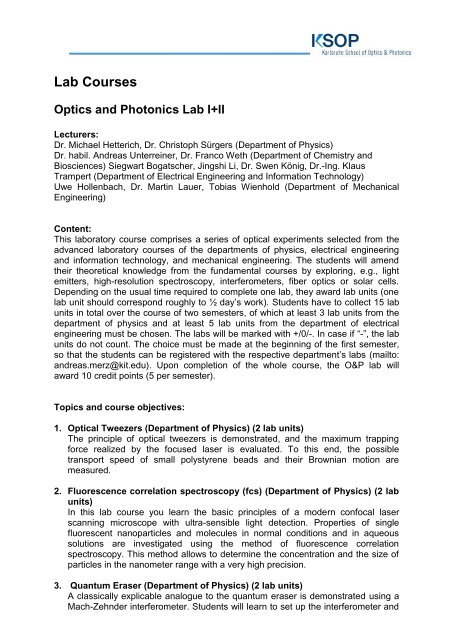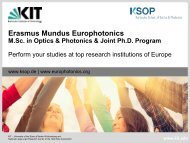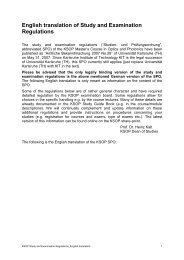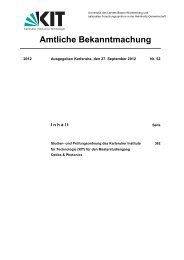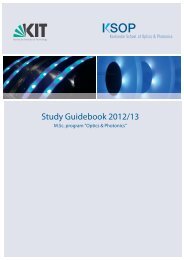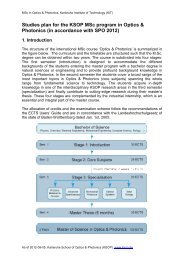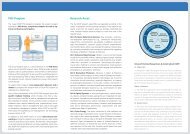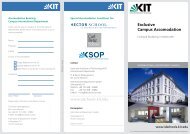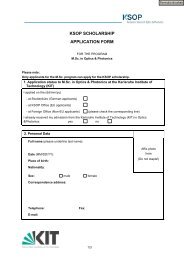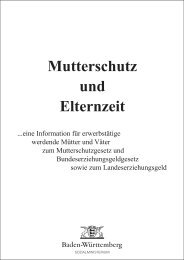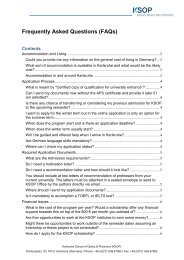Lab Descriptions - Karlsruhe School of Optics & Photonics - KIT
Lab Descriptions - Karlsruhe School of Optics & Photonics - KIT
Lab Descriptions - Karlsruhe School of Optics & Photonics - KIT
Create successful ePaper yourself
Turn your PDF publications into a flip-book with our unique Google optimized e-Paper software.
<strong>Lab</strong> Courses<br />
<strong>Optics</strong> and <strong>Photonics</strong> <strong>Lab</strong> I+II<br />
Lecturers:<br />
Dr. Michael Hetterich, Dr. Christoph Sürgers (Department <strong>of</strong> Physics)<br />
Dr. habil. Andreas Unterreiner, Dr. Franco Weth (Department <strong>of</strong> Chemistry and<br />
Biosciences) Siegwart Bogatscher, Jingshi Li, Dr. Swen König, Dr.-Ing. Klaus<br />
Trampert (Department <strong>of</strong> Electrical Engineering and Information Technology)<br />
Uwe Hollenbach, Dr. Martin Lauer, Tobias Wienhold (Department <strong>of</strong> Mechanical<br />
Engineering)<br />
Content:<br />
This laboratory course comprises a series <strong>of</strong> optical experiments selected from the<br />
advanced laboratory courses <strong>of</strong> the departments <strong>of</strong> physics, electrical engineering<br />
and information technology, and mechanical engineering. The students will amend<br />
their theoretical knowledge from the fundamental courses by exploring, e.g., light<br />
emitters, high-resolution spectroscopy, interferometers, fiber optics or solar cells.<br />
Depending on the usual time required to complete one lab, they award lab units (one<br />
lab unit should correspond roughly to ½ day’s work). Students have to collect 15 lab<br />
units in total over the course <strong>of</strong> two semesters, <strong>of</strong> which at least 3 lab units from the<br />
department <strong>of</strong> physics and at least 5 lab units from the department <strong>of</strong> electrical<br />
engineering must be chosen. The labs will be marked with +/0/-. In case if “-”, the lab<br />
units do not count. The choice must be made at the beginning <strong>of</strong> the first semester,<br />
so that the students can be registered with the respective department’s labs (mailto:<br />
andreas.merz@kit.edu). Upon completion <strong>of</strong> the whole course, the O&P lab will<br />
award 10 credit points (5 per semester).<br />
Topics and course objectives:<br />
1. Optical Tweezers (Department <strong>of</strong> Physics) (2 lab units)<br />
The principle <strong>of</strong> optical tweezers is demonstrated, and the maximum trapping<br />
force realized by the focused laser is evaluated. To this end, the possible<br />
transport speed <strong>of</strong> small polystyrene beads and their Brownian motion are<br />
measured.<br />
2. Fluorescence correlation spectroscopy (fcs) (Department <strong>of</strong> Physics) (2 lab<br />
units)<br />
In this lab course you learn the basic principles <strong>of</strong> a modern confocal laser<br />
scanning microscope with ultra-sensible light detection. Properties <strong>of</strong> single<br />
fluorescent nanoparticles and molecules in normal conditions and in aqueous<br />
solutions are investigated using the method <strong>of</strong> fluorescence correlation<br />
spectroscopy. This method allows to determine the concentration and the size <strong>of</strong><br />
particles in the nanometer range with a very high precision.<br />
3. Quantum Eraser (Department <strong>of</strong> Physics) (2 lab units)<br />
A classically explicable analogue to the quantum eraser is demonstrated using a<br />
Mach-Zehnder interferometer. Students will learn to set up the interferometer and
observe the dis- and reappearance <strong>of</strong> (quantum) interferences for certain<br />
combinations <strong>of</strong> light polarization.<br />
4. Semiconductor spectroscopy (Department <strong>of</strong> Physics) (2 lab units)<br />
By polarization-dependent measurements <strong>of</strong> absorption and transmission spectra<br />
<strong>of</strong> several two- and three-dimensional semiconductor structures it is possible to<br />
extract information <strong>of</strong> the nature <strong>of</strong> semiconductors, e.g. excitons, energy gap,<br />
dimensions, refractive index.<br />
5. Solar Cells (Department <strong>of</strong> Physics) (2 lab units)<br />
Silicon solar cells are analyzed by measuring characteristic curves and efficiency<br />
factors. The students will get an insight into pn-junctions, semiconductor optics<br />
and global energy problems.<br />
6. Laser resonator (Department <strong>of</strong> Physics) (2 lab units)<br />
This lab provides an introduction into optical lab work, the use <strong>of</strong> optical<br />
components is introduced. In particular, a Titan:Sapphire laser is adjusted to<br />
make it lase. Different spectra are taken and its use and application are worked<br />
out.<br />
7. Magneto-optical Kerr effect – MOKE (Department <strong>of</strong> Physics) (2 lab units)<br />
Measurement <strong>of</strong> the magnetization <strong>of</strong> thin films and heterostructures by the<br />
MOKE is from great importance for magneto-optical data storage. Polarization<br />
and refraction <strong>of</strong> light, the Kerr-effect and magnetism are the key terms <strong>of</strong> this<br />
course.<br />
8. Zeeman effect (Department <strong>of</strong> Physics) (2 lab units)<br />
The Zeeman effect <strong>of</strong> Helium atoms is measured with a grating spectrograph.<br />
Fundamental aspects <strong>of</strong> atomic physics are examined in this course, e.g.,<br />
selection rules, g-factor, atom-light-interaction, magnetic quantum number.<br />
9. Fabry-Perot interferometer (Department <strong>of</strong> Physics) (2 lab units)<br />
A Fabry-Perot interferometer allows the determination <strong>of</strong> optical spectra with very<br />
high resolution. The hyperfinestructure spectrum <strong>of</strong> Tl 205 is measured with high<br />
accuracy considering the dispersion <strong>of</strong> the spectrometer.<br />
10. Optoelectronics laboratory (Department <strong>of</strong> Electrical Engineering and<br />
Information Technology) (8 lab units)<br />
This is a series <strong>of</strong> four labs:<br />
a. Light Measurement: The light measurement laboratory will deal with the<br />
measurement <strong>of</strong> light intensity distribution, luminous flux and different<br />
reflector types. These measurements are typically used to evaluate the<br />
performance <strong>of</strong> luminaries.<br />
b. <strong>Optics</strong> on the Nanoscale: The laboratory is concerning with the<br />
theoretical basics and experimental techniques <strong>of</strong> nanoscale optics like<br />
optical antennae. A laser safety instruction is required.<br />
c. Compact fluorescent lamps: Compact fluorescent lamps are operated<br />
on an electronic gear (ballast). Properties <strong>of</strong> the lamp as well as those<br />
<strong>of</strong> the ECG are measured, i.e. real and reactive power as functions <strong>of</strong><br />
2
the line voltage, luminous flux, dependent on system power, rms, lamp<br />
current and line voltage etc.<br />
d. Spectroscopy and optical sensor technologies: The monochromator is<br />
the basic tool for optical metrology. With a practical experiment the lab<br />
should give an overview <strong>of</strong> the physical principles and main properties<br />
<strong>of</strong> this instrument. The topics higher orders, optical limitation,<br />
diffraction, etc. will be discussed and shown with a simple and open<br />
monochromator and Xe-arc lamp. The experiment show also the efforts<br />
and drawbacks <strong>of</strong> the most used optical sensors, the Si-diode and<br />
mulitalkali photomultiplier.<br />
11. Nanotechnology laboratory (Department <strong>of</strong> Electrical Engineering and<br />
Information Technology) (8 lab units)<br />
This lab is limited to a total <strong>of</strong> 10 participants!<br />
This is a series <strong>of</strong> four labs. Since most labs will take place in the clean room<br />
facilities, a proper clean room introduction is a mandatory part <strong>of</strong> this course:<br />
a. E-beam: Electron Beam Microscopy and Electron Beam Lithography<br />
(EBL) are standard methods for analyse and fabrication in micro and<br />
nanotechnology. The laboratory gives a practical introduction how<br />
Electron Beam Microscopy works, where the benefits and limitations<br />
are. Also experience <strong>of</strong> building own nanostructures by electron beam<br />
lithography are given.<br />
b. OLED fabrication: The market <strong>of</strong> organic light emitting diodes (OLEDs)<br />
has attracted a lot <strong>of</strong> attention over the last couple <strong>of</strong> years, due to the<br />
potential for low cost, light weight and flexible devices. In this practical<br />
course we examine the properties <strong>of</strong> polymer OLEDs, that are to be<br />
prepared in a cleanroom environment beforehand. The trainees<br />
become familiar with all fabrication steps <strong>of</strong> solution processed OLEDs<br />
and a typical characterization <strong>of</strong> organic devices.<br />
c. Interference lithography: Interference lithography is a production<br />
method for periodic nanostructures. It is possible to structure large<br />
areas with one- or two-dimensional gratings. In this experiment the<br />
students create a one-dimensional grating with a lattice constant <strong>of</strong> 400<br />
nm. Afterwards they transfer this grating into a silicon substrate using<br />
RIE (reactive ion etching). The aim <strong>of</strong> this experiment is an advanced<br />
comprehension <strong>of</strong> the potentials and problems <strong>of</strong> nanostructuring. A<br />
laser safety instruction is required.<br />
d. Photolithography: This experiment introduces students to the methods<br />
that are used for the fabrication <strong>of</strong> microstructures. Each student<br />
fabricates his/her own structure using standard photolithography and<br />
another one using a lift-<strong>of</strong>f process. During the experiment, students get<br />
to known basic clean room techniques as spin coating, exposure and<br />
development <strong>of</strong> photoresist layers, evaporation <strong>of</strong> metal in a vacuum<br />
chamber and etching through a photoresist mask.<br />
12. Lighting Technology lab (Department <strong>of</strong> Electrical Engineering and<br />
Information Technology) (8 lab units)<br />
3
This lab is limited to a total <strong>of</strong> 10 participants.<br />
This is a series <strong>of</strong> four labs:<br />
a. Farfield goniometer lab (Eulumdat)<br />
b. Nearfield goniometer lab (Ray files)<br />
c. Thermal influence on the spectrum <strong>of</strong> an LED<br />
d. Simulation <strong>of</strong> optical systems<br />
13. Backscattering in optical fibers (Department <strong>of</strong> Electrical Engineering and<br />
Information Technology) (2 lab units)<br />
This module gives an introduction to optical time domain reflectometry. This<br />
scheme monitors fiber optical links for changes in transmission quality or<br />
locations <strong>of</strong> damages to the fiber by evaluating backscattered signals. It is an<br />
important routine employed by all major telecommunication companies to check<br />
the integrity <strong>of</strong> optical links.<br />
14. Integrated <strong>Optics</strong> (Department <strong>of</strong> Electrical Engineering and Information<br />
Technology) (2 lab units)<br />
BPM-simulations <strong>of</strong> integrated waveguides: High refractive index contrast<br />
waveguides are used in integrated optical devices. Typical single mode planar<br />
and stripe waveguides are designed and characterized by beam propagation<br />
simulations with an industrial-standard high-frequency design-suite. This gives a<br />
graphic understanding <strong>of</strong> the actual transmission <strong>of</strong> light as an electromagnetic<br />
wave, extension <strong>of</strong> optical fields and <strong>of</strong> what is meant by “optical mode”.<br />
15. Simulation <strong>of</strong> optical transmitters (Department <strong>of</strong> Electrical Engineering<br />
and Information Technology) (2 lab units)<br />
In this module intensity- and phase-modulated 40 Gbit/s optical signals are<br />
generated, transmitted and received in a simulated environment (Rs<strong>of</strong>t OPTSIM).<br />
Virtually all electrical and optical phenomena in communication networks can be<br />
simulated with this s<strong>of</strong>tware. It is a valuable tool for cost-efficiently designing and<br />
testing new network components before actually employing them in real networks.<br />
16. Generation, transmission and reception <strong>of</strong> digitally modulated signals<br />
Digital (Department <strong>of</strong> Electrical Engineering and Information Technology, 3<br />
lab units)<br />
Quadrature Phase Shift Keying (QPSK), Quadrature Amplitude Modulation<br />
(QAM), or Orthogonal Frequency Division Multiplexing (OFDM) are important<br />
modulation formats used in radi<strong>of</strong>requency (RF) applications, Radio over Fiber<br />
(RoF) systems, as well as in optical communications systems. In this module,<br />
digitally modulated signals are first programmed in s<strong>of</strong>tware, then physically<br />
generated with an Arbitrary Waveform Generator (a fast digital to analog<br />
converter, DAC), modulated onto an optical carrier, transmitted over fiber,<br />
recorded by a Digital Phosphor Oscilloscope (a fast analog to digital converter,<br />
ADC) and finally demodulated and evaluated in s<strong>of</strong>tware again.<br />
17. <strong>Optics</strong> Design <strong>Lab</strong> (Department <strong>of</strong> Electrical Engineering and Information<br />
Technology) (5 lab units):<br />
4
This lab is done at five consecutive afternoons. During this course the students<br />
will learn the use <strong>of</strong> the optic design tool OSLO. It is strongly recommended to<br />
attend the lecture “Optical Engineering” before or during this lab course. The<br />
course comprises the following exercises:<br />
Simulation <strong>of</strong> simple optical systems (glasses, magnifying-glass, microscope,<br />
binoculars, telescope)<br />
Aberrations (spherical, chromatic, astigmatism)<br />
Evaluation <strong>of</strong> picture quality <strong>of</strong> optical systems (aberrations, PSF, MTF)<br />
Computer aided optimization <strong>of</strong> complex optical systems (system optimization,<br />
tolerancing)<br />
18. Optical Waveguides (Department <strong>of</strong> Mechanical Engineering,<br />
Institute <strong>of</strong> Microstructure Technology, Campus North) (2 lab units)<br />
The following two labs <strong>of</strong> the Photonic Systems group are <strong>of</strong>fered by the Institute<br />
<strong>of</strong> Microstructure Technology (IMT) at the <strong>Karlsruhe</strong> Institute <strong>of</strong> Technology (<strong>KIT</strong>).<br />
In addition to the very interesting labs itself, the student will have the opportunity<br />
to gain some insight into this large facility. Transport is possible via the <strong>KIT</strong> shuttle<br />
bus, but must be organized by the students themselves (2 lab units).<br />
a. Integrated optical circuits (IOC): In the lab course the students will be<br />
trained in the characterization <strong>of</strong> planar structured optical waveguides<br />
and circuits manufactured in polymers at IMT by photolithographic<br />
processing. After a short oral introduction the students will be trained in<br />
different measurements techniques:<br />
- optical fiber preparation and splice technique (used for fiber butt<br />
coupling to planar stripe waveguides and to build small fiber networks<br />
in the measurement set ups)<br />
- m-line spectroscopy (measurement <strong>of</strong> the effective mode indices for<br />
different wavelengths, demonstration <strong>of</strong> IWKB calculation method,<br />
defining the refractive index pr<strong>of</strong>ile, the maximum index contrast and<br />
the decay constant depending on UV exposure)<br />
- near field intensity distribution (NFP) measurement (discussion <strong>of</strong> the<br />
mode order and mode field diameter <strong>of</strong> single mode waveguide<br />
structures)<br />
- far field intensity distribution (FFP) measurement (discussion <strong>of</strong> the far<br />
field symmetry, the divergence angle and the calculation <strong>of</strong> numerical<br />
aperture (NA))<br />
- waveguide insertion loss (discussion <strong>of</strong> the different loss parts:<br />
coupling loss, mode field mismatch, mismatch <strong>of</strong> NA, structure loss,<br />
material loss)<br />
- polarization analysis (measurement <strong>of</strong> the polarization ellipse<br />
parameter and demonstration <strong>of</strong> the polarization dependent loss<br />
calculation)<br />
19. Opt<strong>of</strong>luidic dye laser in a foil (Department <strong>of</strong> Mechanical Engineering,<br />
Institute <strong>of</strong> Microstructure Technology, Campus North, 3 lab units)<br />
The objective <strong>of</strong> this lab course is to understand the basic principles <strong>of</strong> opt fluidic<br />
distributed feedback dye lasers. The students will learn how to characterize<br />
opt<strong>of</strong>luidic dye lasers by using a state <strong>of</strong> the art optical setup. During the lab<br />
5
course these lasers will be analyzed regarding their emission spectra and laser<br />
thresholds.<br />
20. Mobile robot platform/ Machine Vision (<strong>of</strong>fered only in the summer term)<br />
(Department <strong>of</strong> Mechanical Engineering, MRT) (2 lab units)<br />
To perform a specified task autonomously is a crucial part in many robotics<br />
applications and requires the interaction between different algorithms. Especially<br />
in dynamic environments, the perception <strong>of</strong> the vicinity <strong>of</strong> the robot is important to<br />
handle unforeseen situations. In recent years, the perception part is usually done<br />
using cameras which <strong>of</strong>fer rich information about the environment. The course<br />
<strong>of</strong>fers the opportunity to apply computer vision and control algorithms using an<br />
autonomous vehicle. It specifically addresses object recognition, collision<br />
avoidance and vehicle control.<br />
21. Femtosecond Spectroscopy in solution (Dep. <strong>of</strong> Chemistry) (2 lab units)<br />
The aim <strong>of</strong> this lab course is to provide the necessary basics to perform ultrafast<br />
spectroscopy experiments in the visible and near-infrared region with laser pulses<br />
<strong>of</strong> about 20 femtosecond duration. A home-built Ti:sapphire femtosecond<br />
oscillator will be set up and used. Laser pulses will be characterized by<br />
determining the time-bandwidth product and/ or recording the impulsive rise in the<br />
transient response <strong>of</strong> a dye molecule after absorption and photoexcitation to its<br />
electronically excited state. Femtosecond laser pulses will then be used to<br />
investigate the photodynamics <strong>of</strong> the dye molecule DTTCI in a polar solvent by<br />
recording its time-resolved response after photoabsorption.<br />
22. Infrared Multipass Cell (Department <strong>of</strong> Chemistry, 3 lab units)<br />
The students will be setting up a multipass cell (based on the principle <strong>of</strong> a Herriot<br />
cavity) from scratch in a table-top experiment with the particular aim <strong>of</strong> using it in<br />
the mid-infrared spectral region (with wavelengths <strong>of</strong> 4.5-12µm). The goal is to get<br />
the students acquainted with the concept <strong>of</strong> cavity and the geometrical optics <strong>of</strong> a<br />
resonator ("stability conditions") which will also be deepened by a few exercises<br />
and calculations. In the course <strong>of</strong> characterizing the cell the students are working<br />
with different types <strong>of</strong> detectors (photodiodes and pyroelectric probe heads) and<br />
beam pr<strong>of</strong>ilers as well as with a pulsed infrared laser light source. Spectral<br />
characterization includes the usage <strong>of</strong> a Fizeau type interferometer.<br />
As a first application the students will take an infrared absorption spectrum <strong>of</strong> a<br />
diluted gas.<br />
23. Vibrational Raman Spectroscopy (Department <strong>of</strong> Chemistry, 2 lab units)<br />
In this lab course the students will take vibrational Raman spectra <strong>of</strong> several<br />
condensed phase samples using a commercial fiber-coupled Raman<br />
spectrometer. Learning the basics <strong>of</strong> resonant and non-resonant Raman<br />
scattering (e.g. selection rules, Raman vs. IR active modes) in molecular<br />
spectroscopy is one <strong>of</strong> the major goals as well as important applications like<br />
efficient Rayleigh line filtering, data evaluation (Stokes and anti-Stokes shift,<br />
evaluation <strong>of</strong> force constants), vibrational isotope effects (e.g. in C6H6 vs C6D6).<br />
Another focus is on the interpretation <strong>of</strong> vibrational Raman spectra.<br />
6
24. Biological fluorescence microscopy (Institute <strong>of</strong> Zoology, Department <strong>of</strong><br />
Cell- and Neurobiology) (3 lab units)<br />
The lab includes a first introduction to the application <strong>of</strong> fluorescence microscopy<br />
in the biosciences. Pre-processed specimens from our current research projects<br />
will be provided and imaged using cutting-edge research microscopes by the<br />
participants. Acquired images will be processes and interpreted.<br />
Learning targets/skills:<br />
In this course the students will get a first hands-on experience in basic optics and<br />
measurement techniques. Students will be expected to have a basic understanding<br />
<strong>of</strong> the underlying theories, good skills in building up and dealing with optical systems,<br />
and the ability to summary their measurements and results in a clear and concise<br />
report.<br />
Pre-requisites:<br />
Prerequisites vary from experiment to experiment. Indispensable is a basic<br />
knowledge <strong>of</strong> optics, some experience in semiconductors is favourable for some <strong>of</strong><br />
the experiments. Students have to prepare for each experiment by impropriating the<br />
required knowledge afore by means <strong>of</strong> preparation material.<br />
Teaching Method:<br />
The main focus <strong>of</strong> this course lays on laboratory work. Before starting the<br />
experiments the students are checked about the underlying theories in a short<br />
interview. Students have to generate an experiment report/data interpretation <strong>of</strong> their<br />
measurements.<br />
Course structure<br />
Lectures 0 SWS<br />
Exercises 0 SWS<br />
7<br />
<strong>Lab</strong> courses 4 SWS<br />
Project work 0 SWS
Performance Appraisal:<br />
Dep. <strong>of</strong> Physics<br />
Dep. <strong>of</strong> Elec. Eng.<br />
Dep. <strong>of</strong> Mech. Eng.<br />
Dep. <strong>of</strong><br />
Chemistry/Biology<br />
interview 33 %<br />
lab work 33 %<br />
experiment report/data interpretation 33 %<br />
interview/lab work 50 %<br />
experiment report /closing meeting 50 %<br />
lab work 70 %<br />
experiment report/data interpretation 30 %<br />
interview/lab work<br />
experiment report / data interpretation<br />
8<br />
50%<br />
50%<br />
Course material:<br />
For each experiment there exists a short description <strong>of</strong> the experiment, the exercises<br />
that have to be handled and a detailed description <strong>of</strong> the underlying theories. This<br />
material will be handed out about one week prior to the lab by the respective lab<br />
supervisor.<br />
Literature:<br />
To supplement the preparation material, students are expected to access the library.<br />
Contact:<br />
Department <strong>of</strong> Physics<br />
Name: Pauline Maffre (LAB 1+2)<br />
E-Mail: pauline.maffre@kit.edu<br />
Name: Chao Gao (LAB 3+4)<br />
E-mail: chao.gao@kit.edu<br />
Name: Muamer Kadic (LAB 5+6)<br />
E-Mail: muamer.kadic@kit.edu<br />
Name: Christoph Sürgers (LAB 7+8+9)<br />
E-Mail: christoph.suergers@kit.edu<br />
Department <strong>of</strong> Electrical Engineering and Information Technology<br />
Name: Dr.-Ing. Klaus Trampert (LAB 10+11+12)<br />
Tel.: 0721 / 608-47065<br />
E-mail: klaus.trampert@kit.edu<br />
Name: Simon Schneider (LAB 13+14)<br />
Tel.: 0721 / 608- 41935<br />
E-mail: somin.schneider@kit.edu
Name: Djorn Karnick (LAB 15+16)<br />
Tel.: 0721 / 608- 47170<br />
E-mail: djorn.karnick@kit.edu<br />
Name: Siegwart Bogatscher (LAB 17)<br />
Tel.: 0721 / 608-45285<br />
E-mail: siegwart.bogatscher@kit.edu<br />
Department <strong>of</strong> Mechanical Engineering:<br />
Name: Uwe Hollenbach (LAB 18)<br />
Tel.: 0721 608-23856<br />
E-mail: uwe.hollenbach@kit.edu<br />
Name: Tobias Wienhold (LAB 19)<br />
Tel.: 0721 608- 25856<br />
E-mail: tobias.wienhold@kit.edu<br />
Name: Dipl.-Ing. Bernd Kitt (LAB 20)<br />
Tel.: 0721 / 608-42744<br />
E-Mail: bernd.kitt@kit.edu<br />
Department <strong>of</strong> Chemistry and Biosciences<br />
Name: Dr. habil. Andreas Unterreiner (LAB 21)<br />
Tel.: +49 721 608 – 47807<br />
E-Mail: andreas.unterreiner@kit.edu<br />
Name: Dr. Oliver Hampe (LAB 22+23)<br />
E-Mail: oliver.hampe@kit.edu<br />
Name: Dr. Franco Weth (LAB 24)<br />
Tel.: 0721 – 608 44849<br />
E-mail: franco.weth@kit.edu<br />
9


